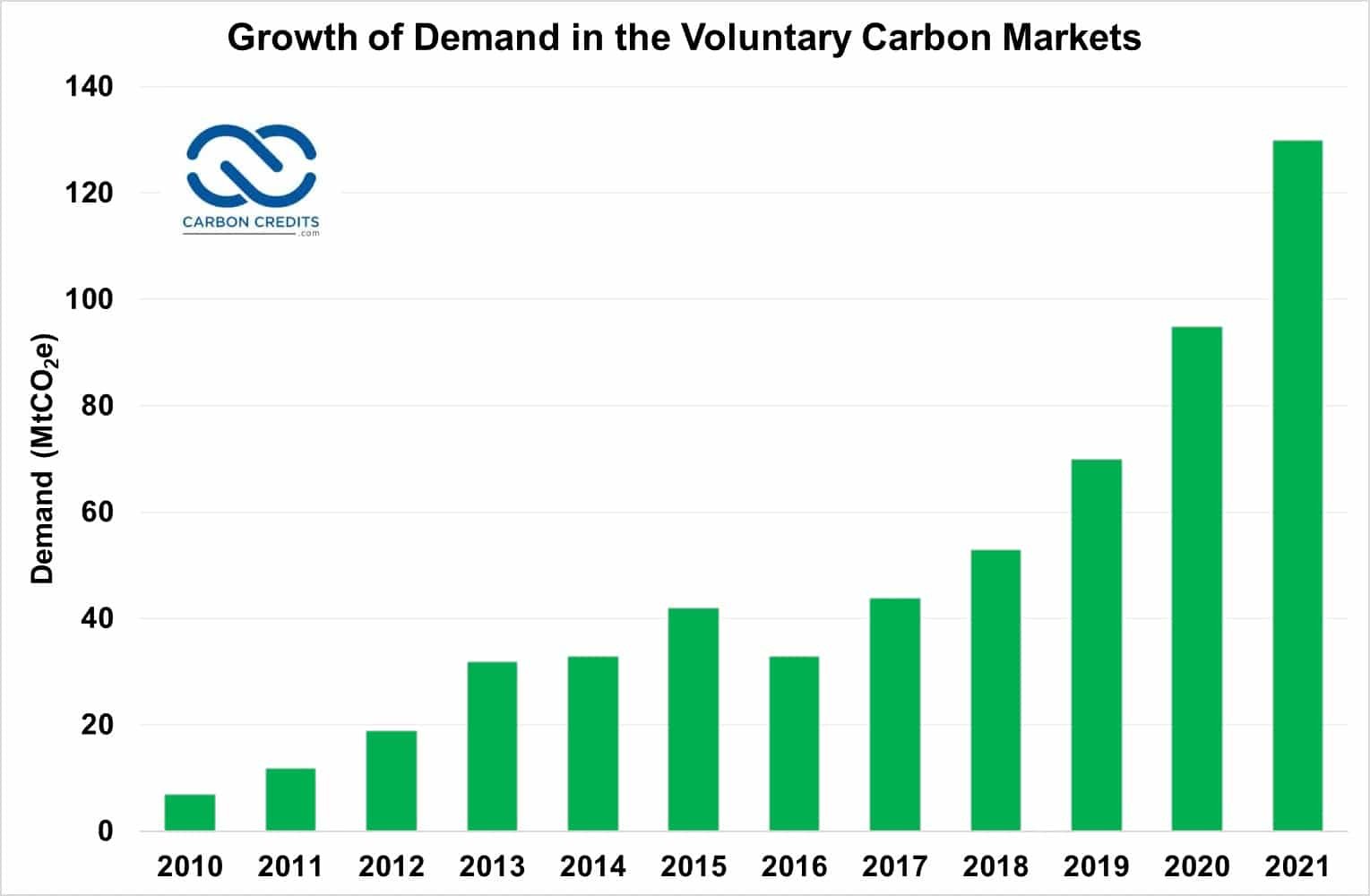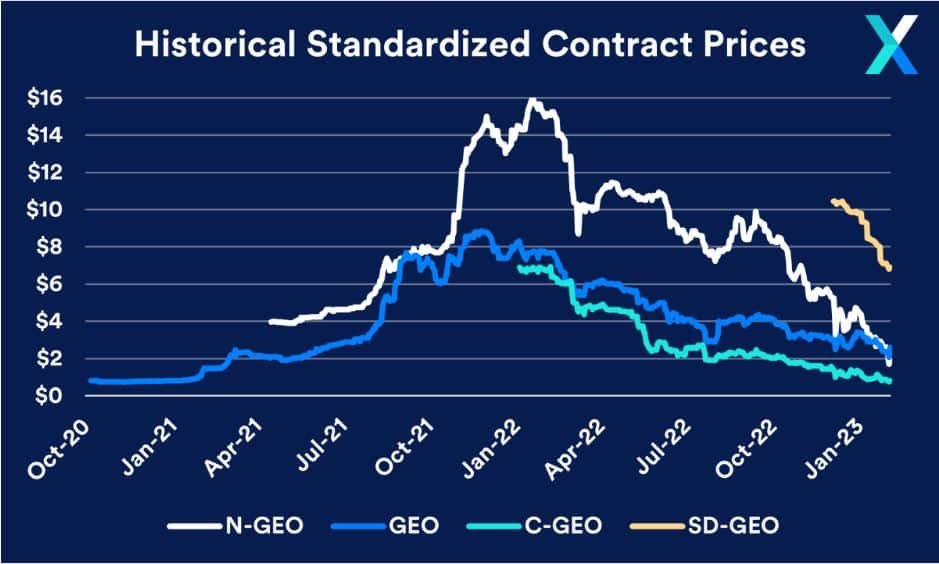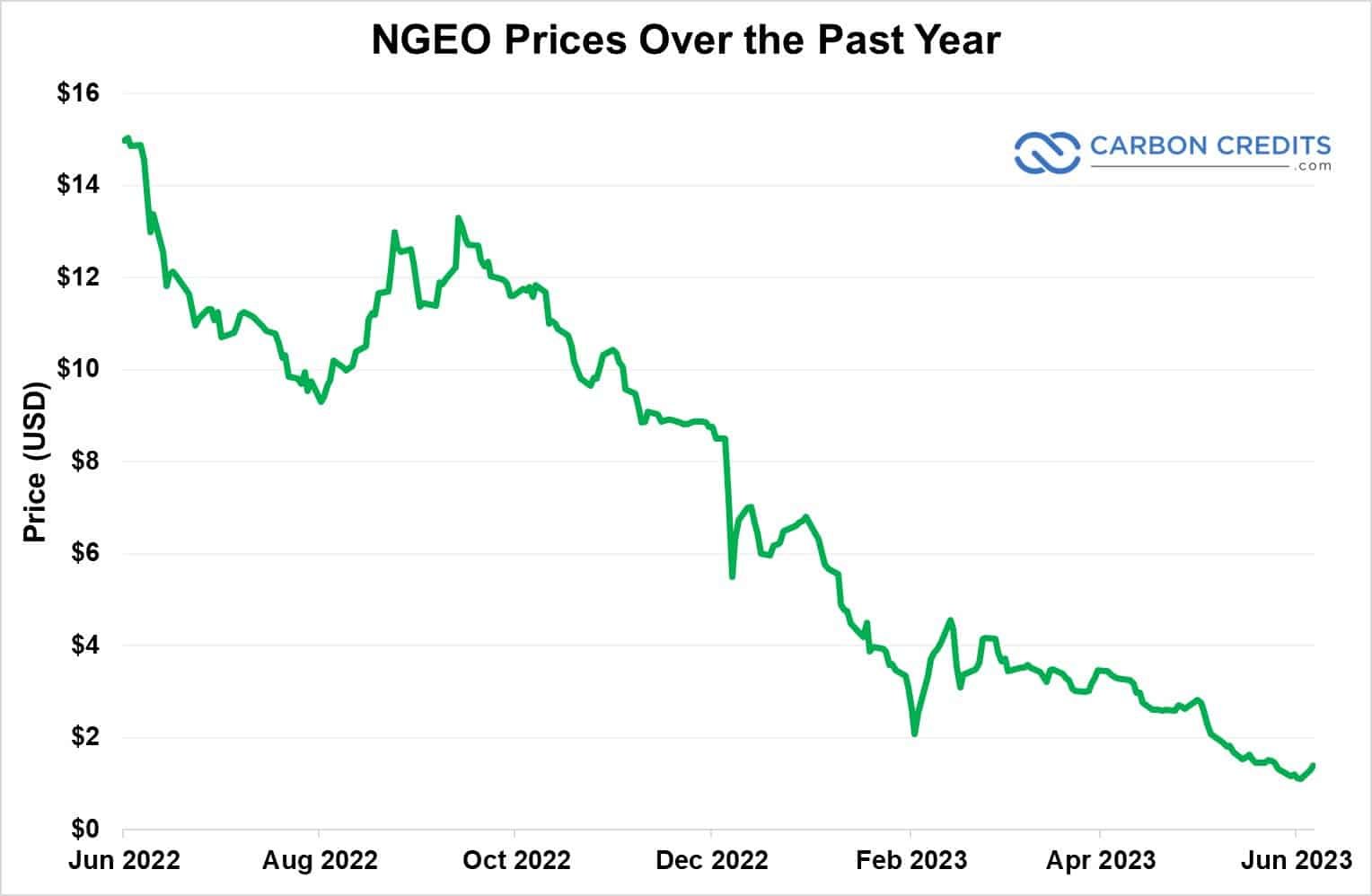The year 2023 marks a pivotal moment in the volatile journey of the carbon credit market. Once hailed as a cornerstone of corporate climate action, voluntary carbon markets are now grappling with a crisis of confidence and a significant downturn in price and demand.
A Rapid Rise and Troubling Slowdown
Voluntary carbon markets (VCMs), a key tool in the global fight against climate change, experienced exponential growth from 2019 to 2021.


As seen above, VCM credits jumped by 86% in 2021 compared to 2019 level. This surge was fueled by escalating corporate net-zero commitments and optimistic forecasts about the market’s potential size.
For instance, Citibank committed to reach net zero emissions by 2050, while using carbon credits to tackle unavoidable emissions. One of the world’s largest biopharmaceutical companies, Pfizer, also pledged to achieve net zero emissions by 2040. The US’ biggest utility, Pacific Gas and Electric (PG&E), also aimed at hitting net zero by 2040 while reducing Scope 1 and 2 emissions by 50% from 2015 levels by 2030.
However, 2022 witnessed a stark slowdown in the VCM’s growth, a trend that continued into 2023. Various factors, including the increasing complexity of market mechanisms and the role of carbon credits in broader sustainability strategies, have contributed to this decline.
The Offset Decline: An Erosion of Confidence
Several high-profile corporations, such as Shell, Nestlé, EasyJet, and Fortescue Metals Group, have recently retreated from carbon offset schemes. This withdrawal stems partly from growing skepticism about the effectiveness of these projects, with concerns about their actual climate benefits and accusations of greenwashing.
- Shell: The MIT Technology Review reported that corporations, including Shell, announced they were backing away from offsets or the claims of carbon neutrality that relied upon them. This shift reflects a broader trend of companies moving away from credits that simply claim to prevent emissions, particularly in light of increasing awareness about the challenges in proving the actual environmental impact of these projects.
- Nestlé: Reuters detailed Nestlé’s decision to move away from investing in carbon offsets for its brands, such as KitKat, to focus more on programs and practices that help reduce greenhouse gas emissions within their own supply chain and operations. This change is part of their strategy to reach their net-zero ambitions, indicating a shift from offsetting to direct emission reductions.
- EasyJet: According to the MIT Technology Review, EasyJet was mentioned as another corporation that had decided to wind down its offsetting program. Instead, EasyJet is now focusing on cutting emissions from its operations, signaling a shift in strategy towards more direct measures of reducing environmental impact.
A significant decrease in demand for offsets was observed, with estimates suggesting a 25% decline from 2021 levels by the end of 2023.
Carbon Price Collapse
The downturn in demand has had a dramatic effect on prices. The Xpansiv market CBL, the world’s largest spot carbon exchange, saw prices of carbon offsets fall by over 80% in an 18-20 month period.


This price decline reflects the broader challenges facing the voluntary carbon market, including questions about the actual environmental impact of the credits and the integrity of projects claiming to offset emissions.
While the VCM prices have been hit, the decline in NGEO (Nature-Based Global Emissions Offsets) prices stands out due to the premium they were trading at over the other offsets last year. With increasing scrutiny on forestry projects, NGEO prices sharply dropped from around $15 in June 2022 to $1 in June this year.
It even declined to below $1 at the time of writing.


One major reason for the downward trend of NGEOs was the tough macroeconomic environment, causing stagnation in demand in 2022. Moreover, the poor outcome for the VCM at COP27, which carries over at the recent COP28, further casted doubts on how carbon offsets fit in corporate net zero plans.
Mark Kenber, VCMI’s Executive Director, commented that though there are many encouraging developments on carbon markets at COP28, agreements “fell short of the mark”. He further stated that:
“For the market to fully develop in the next two years, policymakers can draw on the foundational work of the VCMI and IC-VCM, developing high-integrity VCM and Article 6 markets that deliver the finance that makes ambitious global action possible.”
Over in compliance markets, the EU carbon prices have broken records in February this year, surging past 100 euros. But the EU allowance prices also dipped back to its low levels this month at 78 euros, close to its November 2022 average price.
The region, which has the largest carbon market EU ETS, plans to phase out its free carbon allowances while gradually phasing in its newly introduced carbon tax, known as the Carbon Border Adjustment Mechanism. CBAM will ensure that companies operating inside and outside the bloc remain on the same page in terms of carbon pricing and environmental impact.
Following the EU footsteps, the UK is also set to launch its own CBAM version. It aims to ensure that imported goods from carbon-intensive industries like iron, steel, and cement face fair carbon prices.
A couple of African nations are also gearing up to participate in the carbon arena. New carbon credit exchanges are created in Zimbabwe and Tanzania while Zambia and Kenya have plans to do the same.
Several countries in Asia are also joining the carbon market bandwagon. Indonesia had launched a carbon credit trading market through IDX as part of its 2060 net zero goal. Japan’s first exchange-based carbon market opened in October this year.
Amid all these, the future of carbon markets now stands at a critical juncture. They face the challenge of regaining credibility and functionality amidst growing scrutiny and regulatory changes. How these markets evolve in response to these challenges will significantly impact their role in global climate strategies.
The Inflection Point: What’s Next for Carbon Prices and Trading?
Not all carbon news is grim here in 2023.
On Dec 13th, 2023, Xpansiv’s CBL spot exchange hit a daily trading volume record of 2.13 million tons of carbon credits, signalling robust corporate engagement in carbon offset markets. This surge aligns with the final day of COP28, reflecting an uptick in year-end corporate purchases for sustainability goals.
New transparency requirements in the U.S., Europe, Australia, and California are driving this demand, pushing companies to disclose more about their carbon offset activities.
Allister Furey, CEO and co-founder of Sylvera, noted the fact that regulators are now seeing the critical role of carbon credits in financing the net zero transition. He further said that:
“Disclosures at every step of the carbon journey and for all involved stakeholders will become increasingly important. From the SEC’s coming climate disclosure rules to California’s AB1305, there are significant incoming regulations which should dramatically improve data availability in net zero–and we will begin to see the price of carbon ripple throughout value chains, slowly but surely.”
Since 2020, CBL has traded over 300 million tons, dominating over 95% of the global spot exchange-traded carbon offsets. The record day underscores a heightened market activity during the UN’s COP event.
Meanwhile, the Compliance Credits market has not only attracted immense investment dollars – especially in carbon capture projects – but countries like Canada and the UK are setting higher and higher compliance prices.
NASDAQ Enters the Carbon Credit Market Arena
The NASDAQ Exchange, recognizing the growing importance and potential of the carbon credits market, has recently launched an innovative technology to revolutionize the industry. This new system, aimed at digitizing the issuance, settlement, and custody of carbon credits, is set to enhance the scalability of this nascent market.
Nasdaq’s approach uses smart contracts for secure transactions and promises to bring much-needed standardization and liquidity to attract diverse investors.
Moreover, Nasdaq’s collaboration with Climate Impact X (CIX) marks a significant stride towards developing the global carbon market. This partnership will power CIX’s spot exchange for quality carbon credits, intending to improve price transparency and liquidity in the voluntary carbon credit market.
Addressing the inefficiencies and inconsistencies in the market, this move by Nasdaq and CIX is poised to create a more resilient and scalable trading environment, demonstrating Nasdaq’s commitment to pioneering market transformations in the carbon credit sector.
It’s clear that change is in the air. Companies are not just looking to buy credits; they’re looking to buy credibility and real impact. And as the market matures, it’s becoming more about quality than quantity.
- SEO Powered Content & PR Distribution. Get Amplified Today.
- PlatoData.Network Vertical Generative Ai. Empower Yourself. Access Here.
- PlatoAiStream. Web3 Intelligence. Knowledge Amplified. Access Here.
- PlatoESG. Carbon, CleanTech, Energy, Environment, Solar, Waste Management. Access Here.
- PlatoHealth. Biotech and Clinical Trials Intelligence. Access Here.
- Source: https://carboncredits.com/carbon-prices-and-voluntary-carbon-markets-faced-major-declines-in-2023-whats-next-for-2024/



